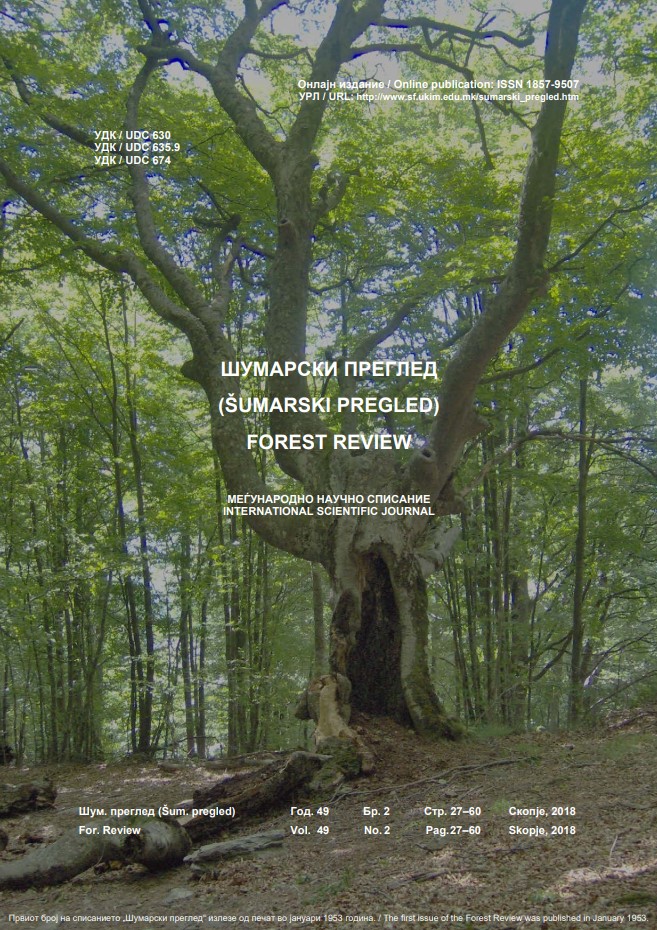Шумарски преглед, год. 49, бр. 2
Forest Review, Vol. 49, No. 2
Issue Articles
Certain edaphoecological factors for upper treeline expansion of forest vegetation in the northern parts of Kozhuf mountain massif in the Republic of Macedonia
Authors: Dejan Mandžukovski, Rossen Tzonev, Marius Dimitrov, Marjan Andreevski
⇑ DOI:
Original scientific article
Abstract:
This paper attempts to define what changes occur with forest vegetation on the northern slopes of the Kozhuf mountain range at upper treeline. For this purpose, we defined three sub-goals: defining the current upper timberline of the forest vegetation, distribution of forest communities on Kozhuf mountain range at the upper treeline, as well as modelling of possible upper timberline of the forest according to temperature indicators. Comparative analysis method was used. The period of analysis covers 80 years. Different cartographic and written materials served as a basic material for analysis. Required sections of topographical maps were geo-referenced and digitalized as separate layers in AUTOCAD software. With layers switching, and with so-called “over-lay analysis” we got the differences in the distribution area in terms of upper treeline shifting. Forest vegetation was surveyed with recording and mapping of vegetation types. Part of it is processed by the method of Braun-Blanquet. The vegetation types development was observed, and the dynamics of populations and species movement was observed through these changes. The obtained results show that with increment of upper treeline of the forest vegetation, the most represented is forest community of Scots pine Fago-Pinetum sylvestris on silicate geological substrate, and relatively smaller areas are accounted to the forest communities of mixed forest of fir and beech Abieti borisii-regis – Fagetum, and pure fir forest Fago-Abietetum, while the small area accounts for Seslerio-Pinetum nigrae and Fago-Abietetum forest communities on limestone geological substrate. Regarding the treeline of the forest in 30 years of the last century and the present state, the greatest expansion is on western exposure, in this case up to maximum of 400 m. The forest vegetation expansion is smallest on eastern exposure.
Keywords: topographic maps, AUTOCAD software, treeline, forest communities, expansion
Challenges of Skopje Green City – Establishing green corridors upon the rivers Lepenec and Serava
Authors: Divna Penchikj, Stefanka Hadzi Pecova
⇑ DOI:
Original scientific article
Abstract:
For years, the City of Skopje has been facing the problem of increasing pollution, congestion, uneven construction, but also the problem of losing free public spaces, especially green. Unfavourable environmental conditions and the diminished quality of life, is mostly reflected in health of residents, but also in their satisfaction of living in the city. The city is becoming an inconvenient and undesirable place to live not only from an environmental point of view, but also from a sociological and economic point of view. Within the last ten years, the City of Skopje has intensified its efforts to attain the status of Green City by adopting the United Nations recommendations for achieving the goals of sustainable development. This article presents the urban aspects that are part of the research and results of the Study on the development of green corridors along the rivers Lepenec and Serava. Green corridors have been recognized as important elements for the enrichment of the green infrastructure of the city, whose basic functions and goals are related to improving the quality of life, mitigating the effects of climate change, preserving biodiversity, increasing the diversity of opportunities in urban areas and establishing sustainable transport corridors.
Keywords: sustainable development, green city, green corridor
Down dead wood in a montane beech forest stands on Deshat Mountain: Down dead wood biomass
Authors: Ekrem Veapi, Daniela Jovanovska, Marija Trenčeva, Nikolčo Velkovski, Slavčo Hristovski
⇑ DOI:
Original scientific article
Abstract:
Down dead wood in forest ecosystems plays a very important role in major ecosystem processes such as decomposition, pedogenesis, erosion prevention, biogeochemical cycles of carbon and nutrients, natural regeneration and provides microhabitats for different organisms. Different aspects of down dead wood have received broad attention in scientific literature especially in terms of carbon sequestration and climate change, biodiversity conservation, etc. However, there are no studies on down dead wood in Macedonian forests. This paper presents the results for the amount of down dead wood biomass (dead branches and dead trees) in five montane beech forest stands in Deshat Mountain, Mavrovo National Park. The investigated forest stands represent five different types of forest in terms of degradation and forestry practices. Large branches (3-5, 5-10, and 10-20 cm) were collected by linear transect with test surfaces of 1 m². The down dead wood biomass (branches and logs) was divided into five categories according to the degree of decomposition. Following, the biomass of all fallen logs on a specific test area was assessed. The highest amount of down dead wood was estimated in the most preserved forest (19.04 t·ha-1), and the lowest in the most degraded forest (2.68 t·ha-1). Biomass of large branches ranged between 1.03 and 9.73 t·ha-1, while the biomass of fallen trees varied between 1.65 and 11.64 t·ha-1. It can be concluded that the old forests are the main accumulators of down dead wood biomass.
Keywords: Down dead wood, biomass, beech forest
Down dead wood in a montane beech forest stands on Deshat Mountain: Carbon sequestration
Authors: Ekrem Veapi, Daniela Jovanovska, Marija Trenčeva, Nikolčo Velkovski, Slavčo Hristovski
⇑ DOI:
Original scientific article
Abstract:
Knowledge on carbon cycling and its sequestration in forest ecosystems is invaluable for understanding of climate change and consequences on the management of forest resources. The paper deals with the results on the content and quantity of carbon in down dead wood in five montane beech forest stands on Deshat Mountain in Mavrovo National Park. The stands were selected to represent five different types of degradation and management practices in beech forests (from highly preserved forest stands with old thick standing trees and large numbers of fallen trees with accumulated biomass, to degraded forest stands represented by a resprouting trees and small amount of coarse biomass). Carbon content was determined by using the Kotzman method. Carbon quantity was calculated based on carbon content and the biomass of dead wood (logs and branches of different sizes and decomposition stages). The highest quantity of carbon in down dead wood was found in the most preserved forest (9.7 t·ha-1), and the lowest – in the most degraded forest (1.4 t·ha-1). Carbon quantity in large branches ranged between 0.52 and 4.91 t·ha-1, while the carbon content of fallen trees varied between 0.59 and 5.98 t·ha-1. It can be concluded that the old forests represent very important storage of down dead wood carbon.
Keywords: forestry management, dead wood, biomass, carbon sequestration




